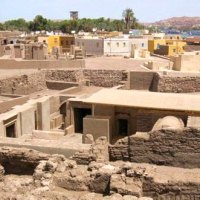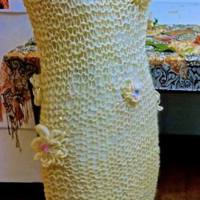A while back, on Radio Germany [short wave], a program was aired on changes in women’s dress in Egypt over the past several decades – towards both western dress and veiling. Although Egypt is a small country and one that has endured millennia of severely extractive domination by a variety of outside powers, rural communities have defied these attempted takeovers of local expression through a series of strategies that are often found in peasant societies – a determination to retain unique styles of local dress, cuisine, architecture, dance, accents/dialects, etc.
Until recently, it was possible to determine where a rural woman [bint al-balad]or man [ibn al-balad] came from by the dress style of the woman and the gallabia and cap style of the man. There are [or were] numerous styles throughout the Nile Valley, I can’t remember the exact number but certainly over 20. In the late 70s and 80s, while working in different areas of the country, I collected dresses that embodied some of these different styles. These were lovely, simple cotton frocks, long and long-sleeved, open at the neck and with a variety of styles of embroidery and/or ruffles and folds – and many different colors and patterns. For the winter, heavier cotton was used than for summer dresses. The best reserved for celebrations; others of a more work-a-day nature:

A style that was found in Upper Egypt

Daily work dresses, Upper Egypt
At the same time Andrea Ruch wrote a book [illustrated] on these different dress styles, published by the American University in Cairo Press, I think. Also, an Egyptian woman began a systematic purchase of them throughout Egypt, opening a little shop in her home in Cairo which I used to visit – Shahira Mahriz, I think was her full name; she was interviewed on the German radio program and explained that she now has some of the last remaining styles made in some of the areas.
Now, as reported by Radio Germany, many of these local styles have already disappeared as peasant women take up more western styles of dress as well as the hijab [Islamic head covering].
Disappearance of regional differences is relevant also to variations in food. Although not as distinct as dress, unique cooking styles or cuisines are [were] found in different areas of Egypt, especially in relation to cheese types and bread. Of cheeses, there is [were] gibna rumi, gibna bayda, karish, mish, rahseer, and daani – in addition to the dairy/grain product of kishk. Many are linked to specific areas of Egypt and their different agro-ecological conditions.
As for bread, the different types vary considerably as one travels south from Alexandria on the Medeterranian – different varieties of bread and bread-baking as they are linked to specific agro-ecological conditions moving down the Nile Valley from Egypt through Sudan and into the tropics of Central Africa. In Egypt, in addition to aysh baladi, one finds aysh nashif, aysh shamsy, and others.

aysh as-shamsy, or 'sun bread', baked in Upper Egypt

aysh an-nashif, or 'dry bread', also made in Upper Egypt. Suzan Weeks
While I cannot speak for cheese types, it is the case that regional breads are being replaced by the ubiquitous ‘aysh baladi bread that is heavily subsidized by the government.

An early form of commercial bread production in Cairo
In France, by contrast, the process of homogenizing food types is apparently being prevented through commercialization of regional cuisines – terroir – and, as aysh baladi in Egypt, also heavily subsidized, I believe.
Here’s an interesting difference between the Egyptian and French examples:
In Egypt, on the one hand there is a continuation of top-down strategies that began 5 millennia ago – now expressed as regularized/standardized subsidizing of breads [with a view to preventing bread riots!], and on the other hand [as part of economic incorporation into a globalizing economy] there is the introduction of fast foods and western style dress and related imports. These dynamics are eroding regional differences in the country leading to a flatness/sameness.
In France, by contrast, local differences of dress and cuisine are celebrated and have been commercialized, perhaps thus helping to assure their continuation alongside fast foods, standardized dress, and so forth.
Very different trajectories?


























Fascinating post. I’ve recently been talking to relatives in Upper Egypt specifically about bread-making. I discovered techniques and types of bread that I had never heard of. There’s a pressing need to at least document these methods. I’m afraid revival may prove too difficult in light of the government policies and the cultural homogenization you described above.
LikeLike
Thanks, nevine. Yes, just as the dresses, bread types and possibly also local cheeses and cheese’type products that are not well-known (like kishk) will disappear. Sad.
LikeLike
Excellent post! Local dialects are also fading and replaced with a more Cairene vocabulary and accent, as introduced by the ubiquitous TV & satellite sets. Many of these dialects used to have large amounts of vocabulary & expressions that were etymologically 100% ancient Egyptian, rather than Arabic, Turkish, Greek, or French
LikeLike
Thank you, Menna – that’s interesting also about dialects but not surprising. When I did my first work in Upper Egypt – and this is the late 1970’s, – the Sa’idi dialect at that time was quite pronounced but with the coming of electicity, radios, tv, etc I did see this changing.
LikeLike